Exploring the Streetscape Perceptions from the Perspective of Salient Landscape Element Combination: An Interpretable Machine Learning Approach for Optimizing Visual Quality of Streetscapes
Abstract
1. Introduction
- A breakthrough in landscape element combination extraction: We propose a novel method—Salient Landscape Element Combination Extraction Method (SLECEM)—which integrates UniSal saliency detection and semantic segmentation to extract visually dominant landscape combinations, advancing perceptual modeling from isolated features to structural interactions.
- Localized perception modeling mechanism: By integrating the global PlacePulse 2.0 dataset with a locally annotated expert dataset, we train a two-stage deep neural network, achieving over 75% accuracy, enhancing adaptability to Chinese urban contexts.
- Advancement in interpretability analysis: Through the proposed multi-dimensional feature–perception coupling framework, we incorporate interpretable machine learning techniques (XGBoost + SHAP) to uncover both linear and nonlinear effects of visual features and apply K-Means clustering to reveal distinct perception patterns across streetscape types.
- Perception-oriented spatial strategy output: This study proposes targeted streetscape layout optimization strategies based on different perceptual goals (such as beauty, safety, and liveliness). These differentiated strategies offer practical and quantifiable guidance for urban design.
2. Data and Methodology
2.1. Research Framework
2.2. SVIs Collection and Perceptual Dimension Selection
2.2.1. SVIs Collection
2.2.2. Perceptual Dimension Selection
2.3. Data Collection and Processing Methods
2.3.1. Objective Features
- Individual Feature: Low-Level Visual Features (LLVFs);
- 2.
- Individual Feature: High-Level Semantic Features (HLSFs);
- 3.
- Landscape Element Combination Features;
2.3.2. Subjective Streetscape Perceptions
2.4. Analysis Methods
3. Experiments and Results
3.1. Data Distribution
3.1.1. Distribution of Objective Features
3.1.2. Spatial Distribution of Subjective Streetscape Perceptions
3.2. SHAP-Based Interpretation of the Black Box in Perception Modeling
3.2.1. XGBoost Model Construction
3.2.2. Feature Contribution Analysis
3.3. SLECEM-Based Exploration of Landscape Element Combination
3.3.1. K-Means Clustering of Landscape Element Combination
3.3.2. Weighting Perception Dimensions for Different Urban Scenarios
3.3.3. Perception-Oriented Streetscape Configuration Strategies
4. Discussion
4.1. Characteristics of Streetscape Perceptual Distribution
4.2. Multi-Dimensional Feature-Based Interpretability Analysis of Perceptions
4.2.1. Analysis of LLVFs and HLSFs
4.2.2. Analysis of Landscape Element Combination Features
4.3. Layout Strategies for Optimizing Streetscape Visual Quality
4.4. Limitations and Future Research
5. Conclusions
Author Contributions
Funding
Data Availability Statement
Conflicts of Interest
References
- Xu, J.; Liu, N.; Polemiti, E.; Garcia-Mondragon, L.; Tang, J.; Liu, X.; Lett, T.; Yu, L.; Nöthen, M.M.; Feng, J.; et al. Effects of urban living environments on mental health in adults. Nat. Med. 2023, 29, 1456–1467. [Google Scholar] [CrossRef]
- Harmaakorpi, V.; Kari, K.; Parjanen, S. City design management as a local competitiveness factor. Place Brand. Public Dipl. 2008, 4, 169–181. [Google Scholar] [CrossRef]
- Appleyard, D.; Lintell, M. The environmental quality of city streets: The residents’ viewpoint. J. Am. Inst. Planners 1972, 38, 84–101. [Google Scholar] [CrossRef]
- Cheng, L.; Chu, S.; Zong, W.; Li, S.; Wu, J.; Li, M. Use of tencent street view imagery for visual perception of streets. ISPRS Int. J. Geo-Inf. 2017, 6, 265. [Google Scholar] [CrossRef]
- Callaghan, A.; McCombe, G.; Harrold, A.; McMeel, C.; Mills, G.; Moore-Cherry, N.; Cullen, W. The impact of green spaces on mental health in urban settings: A scoping review. J. Ment. Health 2020, 30, 179–193. [Google Scholar] [CrossRef]
- Batistatou, A.; Vandeville, F.; Delevoye-Turrell, Y.N. Virtual reality to evaluate the impact of colorful interventions and nature elements on spontaneous walking, gaze, and emotion. Front. Virtual Real. 2022, 3, 819597. [Google Scholar] [CrossRef]
- Zhang, Y.; Fu, X.; Lv, C.; Li, S. The premium of public perceived greenery: A framework using multiscale GWR and deep learning. Int. J. Environ. Res. Public Health 2021, 18, 6809. [Google Scholar] [CrossRef]
- Zhang, Z.; Fisher, T.; Wang, H. Campus environmental quality and streetscape features related to walking activity. J. Asian Arch. Build. Eng. 2023, 23, 405–423. [Google Scholar] [CrossRef]
- Dong, L.; Jiang, H.; Li, W.; Qiu, B.; Wang, H.; Qiu, W. Assessing impacts of objective features and subjective perceptions of street environment on running amount: A case study of Boston. Landsc. Urban Plan. 2023, 235, 104756. [Google Scholar] [CrossRef]
- He, N.; Li, G. Urban neighbourhood environment assessment based on street view image processing: A review of research trends. Environ. Challeng. 2021, 4, 100090. [Google Scholar] [CrossRef]
- Zhou, H.; Wang, J.; Wilson, K. Impacts of perceived safety and beauty of park environments on time spent in parks: Examining the potential of street view imagery and phone-based GPS data. Int. J. Appl. Earth Obs. Geoinf. 2022, 115, 103078. [Google Scholar] [CrossRef]
- Ogawa, Y.; Oki, T.; Zhao, C.; Sekimoto, Y.; Shimizu, C. Evaluating the subjective perceptions of streetscapes using street-view images. Landsc. Urban Plan. 2024, 247, 105073. [Google Scholar] [CrossRef]
- Zeng, Q.; Gong, Z.; Wu, S.; Zhuang, C.; Li, S. Measuring cyclists’ subjective perceptions of the street riding environment using K-means SMOTE-RF model and street view imagery. Int. J. Appl. Earth Obs. Geoinf. 2024, 128, 103739. [Google Scholar] [CrossRef]
- Qiu, W.; Li, W.; Liu, X.; Huang, X. Subjectively measured streetscape perceptions to inform urban design strategies for Shanghai. ISPRS Int. J. Geo-Inf. 2021, 10, 493. [Google Scholar] [CrossRef]
- Ewing, R.; Handy, S. Measuring the unmeasurable: Urban design qualities related to walkability. J. Urban Des. 2009, 14, 65–84. [Google Scholar] [CrossRef]
- Filova, L.; Vojar, J.; Svobodova, K.; Sklenicka, P. The effect of landscape type and landscape elements on public visual preferences: Ways to use knowledge in the context of landscape planning. J. Environ. Plan. Manag. 2014, 58, 2037–2055. [Google Scholar] [CrossRef]
- Sung, H.; Go, D.; Choi, C.-G.; Cheon, S.; Park, S. Effects of street-level physical environment and zoning on walking activity in Seoul, Korea. Land Use Policy 2015, 49, 152–160. [Google Scholar] [CrossRef]
- Tang, F.; Zeng, P.; Wang, L.; Zhang, L.; Xu, W. Urban perception evaluation and street refinement governance supported by street view visual elements analysis. Remot. Sens. 2024, 16, 3661. [Google Scholar] [CrossRef]
- Rui, J.; Xu, Y. Beyond built environment: Unveiling the interplay of streetscape perceptions and cycling behavior. Sustain. Cities Soc. 2024, 109, 105525. [Google Scholar] [CrossRef]
- Zhao, J.; Suo, W. Research on the Construction and Application of a SVM-Based Quantification Model for Streetscape Visual Complexity. Land 2024, 13, 1953. [Google Scholar] [CrossRef]
- Zhu, Y.; Su, F.; Han, X.; Fu, Q.; Liu, J. Uncovering the drivers of gender inequality in perceptions of safety: An interdisciplinary approach combining street view imagery, socio-economic data and spatial statistical modelling. Int. J. Appl. Earth Obs. Geoinf. 2024, 134, 104230. [Google Scholar] [CrossRef]
- Gehl, J. Cities for People; Island Press: Washington, DC, USA, 2010. [Google Scholar]
- Lin, L.; Moudon, A.V. Objective versus subjective measures of the built environment, which are most effective in capturing associations with walking? Health Place 2010, 16, 339–348. [Google Scholar] [CrossRef]
- Zhou, H.; He, S.; Cai, Y.; Wang, M.; Su, S. Social inequalities in neighborhood visual walkability: Using street view imagery and deep learning technologies to facilitate healthy city planning. Sustain. Cities Soc. 2019, 50, 101605. [Google Scholar] [CrossRef]
- Wang, R.; Liu, Y.; Lu, Y.; Zhang, J.; Liu, P.; Yao, Y.; Grekousis, G. Perceptions of built environment and health outcomes for older Chinese in Beijing: A big data approach with street view images and deep learning technique. Comput. Environ. Urban Syst. 2019, 78, 101386. [Google Scholar] [CrossRef]
- Rui, J.; Cai, C. Plausible or misleading? Evaluating the adaption of the place pulse 2.0 dataset for predicting subjective perception in Chinese urban landscapes. Habitat Int. 2025, 157, 103333. [Google Scholar] [CrossRef]
- Dubey, A.; Naik, N.; Parikh, D.; Raskar, R.; Hidalgo, C.A. Deep learning the city: Quantifying Urban perception at a global scale. In Proceedings of the European Conference on Computer Vision, Amsterdam, The Netherlands, 11–14 October 2016; pp. 196–212. [Google Scholar] [CrossRef]
- Zhang, F.; Zhou, B.; Liu, L.; Liu, Y.; Fung, H.H.; Lin, H.; Ratti, C. Measuring human perceptions of a large-scale urban region using machine learning. Landsc. Urban Plan. 2018, 180, 148–160. [Google Scholar] [CrossRef]
- Wang, L.; Han, X.; He, J.; Jung, T. Measuring residents’ perceptions of city streets to inform better street planning through deep learning and space syntax. ISPRS J. Photogramm. Remote. Sens. 2022, 190, 215–230. [Google Scholar] [CrossRef]
- Huang, B.; Zhou, Y.; Li, Z.; Song, Y.; Cai, J.; Tu, W. Evaluating and characterizing urban vibrancy using spatial big data: Shanghai as a case study. Environ. Plan. B Urban Anal. City Sci. 2019, 47, 1543–1559. [Google Scholar] [CrossRef]
- Ye, Y.; Li, D.; Liu, X. How block density and typology affect urban vitality: An exploratory analysis in Shenzhen, China. Urban Geogr. 2018, 39, 631–652. [Google Scholar] [CrossRef]
- Wei, J.; Yue, W.; Li, M.; Gao, J. Mapping human perception of urban landscape from street-view images: A deep-learning approach. Int. J. Appl. Earth Obs. Geoinf. 2022, 112, 102886. [Google Scholar] [CrossRef]
- McLeod, S. Maslow’s Hierarchy of Needs. Simply Psychol. 2007, 1, 1–18. Available online: https://www.simplypsychology.org/maslow.html?ez_vid=2cae626a2fe896279da43d587baa3eb663083817 (accessed on 13 April 2025).
- Lederbogen, F.; Kirsch, P.; Haddad, L.; Streit, F.; Tost, H.; Schuch, P.; Wüst, S.; Pruessner, J.C.; Rietschel, M.; Deuschle, M.; et al. City living and urban upbringing affect neural social stress processing in humans. Nature 2011, 474, 498–501. [Google Scholar] [CrossRef]
- Mehta, V.; Bosson, J.K. Revisiting Lively streets: Social interactions in public space. J. Plan. Educ. Res. 2018, 41, 160–172. [Google Scholar] [CrossRef]
- Wang, Y.; Qiu, W.; Jiang, Q.; Li, W.; Ji, T.; Dong, L. Drivers or pedestrians, whose dynamic perceptions are more effective to explain street vitality? A case study in Guangzhou. Remot. Sens. 2023, 15, 568. [Google Scholar] [CrossRef]
- Jin, X.; Wang, J. Assessing Linear Urban Landscape from dynamic visual perception based on urban morphology. Front. Arch. Res. 2021, 10, 202–219. [Google Scholar] [CrossRef]
- Stamps, A.E. Fractals, skylines, nature and beauty. Landsc. Urban Plan. 2002, 60, 163–184. [Google Scholar] [CrossRef]
- Berg, A.E.V.D.; Joye, Y.; Koole, S.L. Why viewing nature is more fascinating and restorative than viewing buildings: A closer look at perceived complexity. Urban For. Urban Green. 2016, 20, 397–401. [Google Scholar] [CrossRef]
- Sigaki, H.Y.D.; Perc, M.; Ribeiro, H.V. History of art paintings through the lens of entropy and complexity. Proc. Natl. Acad. Sci. USA 2018, 115, E8585–E8594. [Google Scholar] [CrossRef]
- Bertamini, M.; Rampone, G.; Makin, A.D.; Jessop, A. Symmetry preference in shapes, faces, flowers and landscapes. PeerJ 2019, 7, e7078. [Google Scholar] [CrossRef]
- Lang, C.; Nguyen, T.V.; Katti, H.; Yadati, K.; Kankanhalli, M.; Yan, S. Depth matters: Influence of depth cues on visual saliency. In Proceedings of the Computer Vision–ECCV 2012: 12th European Conference on Computer Vision, Florence, Italy, 7–13 October 2012. Proceedings, Part II 12. [Google Scholar] [CrossRef]
- Yildirim, K.; Hidayetoglu, M.L.; Capanoglu, A. Effects of interior colors on mood and preference: Comparisons of two living rooms. Percept. Mot. Ski. 2011, 112, 509–524. [Google Scholar] [CrossRef]
- Gu, L.; Dimitrov-Discher, A.; Knöll, M.; Roe, J. Cool colors promote a restorative sidewalk experience: A study on effects of color and pattern design of ground murals on mood states and perceived restorativeness using 2D street view images. Environ. Plan. B Urban Anal. City Sci. 2024, 52, 1055–1070. [Google Scholar] [CrossRef]
- Gu, L.; Batistatou, A.; Delevoye, Y.; Roe, J.; Knöll, M. Using Artificial Ground Color to Promote a Restorative Sidewalk Experience: An Experimental Study Based on Manipulated Street View Images. 2021. Available online: https://lilloa.univ-lille.fr/bitstream/handle/20.500.12210/58758.1/Gu2021.pdf?sequence=1&isAllowed=y (accessed on 15 May 2025).
- Jahanmiri, F.; Parker, D.C. An Overview of Fractal Geometry Applied to Urban Planning. Land 2022, 11, 475. [Google Scholar] [CrossRef]
- Zhou, B.; Xu, S.; Yang, X.-X. Computing the color complexity of images. In Proceedings of the 2015 12th International Conference on Fuzzy Systems and Knowledge Discovery (FSKD), Zhangjiajie, China, 15–17 August 2015. [Google Scholar] [CrossRef]
- Zhou, B.; Zhao, H.; Puig, X.; Fidler, S.; Barriuso, A.; Torralba, A. Scene Parsing through ADE20K Dataset. In Proceedings of the IEEE Conference on Computer Vision and Pattern Recognition, Honolulu, HI, USA, 21–26 July 2017. [Google Scholar] [CrossRef]
- Zhou, B.; Zhao, H.; Puig, X.; Xiao, T.; Fidler, S.; Barriuso, A.; Torralba, A. Semantic Understanding of Scenes Through the ADE20K Dataset. Int. J. Comput. Vis. 2018, 127, 302–321. [Google Scholar] [CrossRef]
- Eriksen, C.W.; James, J.D.S. Visual attention within and around the field of focal attention: A zoom lens model. Percept. Psychophys. 1986, 40, 225–240. [Google Scholar] [CrossRef]
- Droste, R.; Jiao, J.; Noble, J.A. Unified image and video saliency modeling. In Proceedings of the Computer Vision–ECCV 2020: 16th European Conference, Glasgow, UK, 23–28 August 2020. Proceedings, Part V 16, 2020. [Google Scholar] [CrossRef]
- Jiang, M.; Huang, S.; Duan, J.; Zhao, Q. SALICON: Saliency in Context. In Proceedings of the 2015 IEEE Conference on Computer Vision and Pattern Recognition (CVPR), Boston, MA, USA, 7–12 June 2015. [Google Scholar] [CrossRef]
- Larkin, A.; Gu, X.; Chen, L.; Hystad, P. Predicting perceptions of the built environment using GIS, satellite and street view image approaches. Landsc. Urban Plan. 2021, 216, 104257. [Google Scholar] [CrossRef]
- Kruithof, M.C.; Bouma, H.; Fischer, N.M.; Schutte, K.; Burgess, D.; Owen, G.; Carlysle-Davies, F.; Stokes, R.J.; Yitzhaky, Y. Object recognition using deep convolutional neural networks with complete transfer and partial frozen layers. In Proceedings of the Optics and Photonics for Counterterrorism, Crime Fighting, and Defence XII, Edinburgh, UK, 26–27 September 2016. [Google Scholar] [CrossRef]
- Ding, B.; Qian, H.; Zhou, J. Activation functions and their characteristics in deep neural networks. In Proceedings of the 2018 Chinese Control and Decision Conference (CCDC), Shenyang, China, 9–11 June 2018; pp. 1836–1841. [Google Scholar] [CrossRef]
- Wu, H.; Gu, X. Towards dropout training for convolutional neural networks. Neural Networks 2015, 71, 1–10. [Google Scholar] [CrossRef]
- Yue, H. Investigating the influence of streetscape environmental characteristics on pedestrian crashes at intersections using street view images and explainable machine learning. Accid. Anal. Prev. 2024, 205, 107693. [Google Scholar] [CrossRef]
- Li, H.; Miao, L. A Study of the Non-Linear Relationship Between Urban Morphology and Vitality in Heritage Areas Based on Multi-Source Data and Machine Learning: A Case Study of Dalian. ISPRS Int. J. Geo-Inf. 2025, 14, 177. [Google Scholar] [CrossRef]
- Ji, D.; Tian, J.; Zhang, J.; Zeng, J.; Namaiti, A. Identification and Spatiotemporal Evolution Analysis of the Urban–Rural Fringe in Polycentric Cities Based on K-Means Clustering and Multi-Source Data: A Case Study of Chengdu City. Land 2024, 13, 1727. [Google Scholar] [CrossRef]
- Li, C.; Managi, S. Impacts of community attachment and community livability on environmental activity according to XGBoost and SHAP. Cities 2024, 156, 105559. [Google Scholar] [CrossRef]
- Kawshalya, L.W.G.; Weerasinghe, U.G.D.; Chandrasekara, D.P.; Singh, K.K. The impact of visual complexity on perceived safety and comfort of the users: A study on urban streetscape of Sri Lanka. PLoS ONE 2022, 17, e0272074. [Google Scholar] [CrossRef]
- Shayestefar, M.; Pazhouhanfar, M.; van Oel, C.; Grahn, P. Exploring the influence of the visual attributes of kaplan’s preference matrix in the assessment of urban parks: A discrete choice analysis. Sustainability 2022, 14, 7357. [Google Scholar] [CrossRef]
- Che, J.; Sun, X.; Gallardo, V.; Nadal, M. Cross-cultural empirical aesthetics. Prog. Brain Res. 2018, 237, 77–103. [Google Scholar] [CrossRef]
- Weber, R.; Schnier, J.; Jacobsen, T. Aesthetics of streetscapes: Influence of fundamental properties on aesthetic judgments of urban space. Percept. Mot. Ski. 2008, 106, 128–146. [Google Scholar] [CrossRef]
- Gaekwad, J.S.; Moslehian, A.S.; Roös, P.B.; Walker, A. A meta-analysis of emotional evidence for the biophilia hypothesis and implications for biophilic Design. Front. Psychol. 2022, 13, 750245. [Google Scholar] [CrossRef]
- Lindal, P.J.; Hartig, T. Effects of urban street vegetation on judgments of restoration likelihood. Urban For. Urban Green. 2015, 14, 200–209. [Google Scholar] [CrossRef]
- Zhang, Z.; Zhuo, K.; Wei, W.; Li, F.; Yin, J.; Xu, L. Emotional responses to the visual patterns of urban streets: Evidence from physiological and subjective indicators. Int. J. Environ. Res. Public Health 2021, 18, 9677. [Google Scholar] [CrossRef]
- Alkhresheh, M.M. Enclosure as a Function of Height-To-Width Ratio and Scale: Its Influence on User’s Sense of Comfort and Safety in Urban Street Space University of Florida Gainesville, FL. 2007. Available online: https://www.researchgate.net/profile/Majdi-Alkhresheh/publication/267307437_ENCLOSURE_AS_A_FUNCTION_OF_HEIGHT-TO-WIDTH_RATIO_AND_SCALE_ITS_INFLUENCE_ON_USER%27S_SENSE_OF_COMFORT_AND_SAFETY_IN_URBAN_STREET_SPACE/links/5551115408ae956a5d25ddf0/ENCLOSURE-AS-A-FUNCTION-OF-HEIGHT-TO-WIDTH-RATIO-AND-SCALE-ITS-INFLUENCE-ON-USERS-SENSE-OF-COMFORT-AND-SAFETY-IN-URBAN-STREET-SPACE.pdf (accessed on 15 April 2025).
- Lindal, P.J.; Hartig, T. Architectural variation, building height, and the restorative quality of urban residential streetscapes. J. Environ. Psychol. 2013, 33, 26–36. [Google Scholar] [CrossRef]
- Wong, M.S.; Nichol, J.; Ng, E. A study of the “wall effect” caused by proliferation of high-rise buildings using GIS techniques. Landsc. Urban Plan. 2011, 102, 245–253. [Google Scholar] [CrossRef]
- Lee, S.; Lee, J.; Mastrigt, S.H.-V.; Kim, E. What cities have is how people travel: Conceptualizing a data-mining-driven modal split framework. Cities 2022, 131, 103902. [Google Scholar] [CrossRef]
- Jandhyala, R. Delphi, non-RAND modified Delphi, RAND/UCLA appropriateness method and a novel group awareness and consensus methodology for consensus measurement: A systematic literature review. Curr. Med. Res. Opin. 2020, 36, 1873–1887. [Google Scholar] [CrossRef]
- Zhang, S.; Xiong, K.; Fei, G.; Zhang, H.; Chen, Y. Aesthetic value protection and tourism development of the world natural heritage sites: A literature review and implications for the world heritage karst sites. Heritage Sci. 2023, 11, 30. [Google Scholar] [CrossRef]
- Arefi, M.F.; Poursadeqiyan, M. Health, safety, and environmental status of Iranian school: A systematic review. J. Educ. Health Promot. 2020, 9, 297. [Google Scholar] [CrossRef]
- Gao, M.; Zhu, X.; Cheng, X. Safety—Premise for play: Exploring how characteristics of outdoor play spaces in urban residential areas influence children’s perceived safety. Cities 2024, 152, 105236. [Google Scholar] [CrossRef]
- Jiang, B.; Larsen, L.; Deal, B.; Sullivan, W.C. A dose–response curve describing the relationship between tree cover density and landscape preference. Landsc. Urban Plan. 2015, 139, 16–25. [Google Scholar] [CrossRef]
- Iamtrakul, P.; Chayphong, S.; Kantavat, P.; Nakamura, K.; Hayashi, Y.; Kijsirikul, B.; Iwahori, Y. Assessing Subjective and Objective Road Environment Perception in the Bangkok Metropolitan Region, Thailand: A Deep Learning Approach Utilizing Street Images. Sustainability 2024, 16, 1494. [Google Scholar] [CrossRef]
- Quercia, D.; Schifanella, R.; Aiello, L.M. The shortest path to happiness: Recommending beautiful, quiet, and happy routes in the city. In Proceedings of the 25th ACM Conference on Hypertext and Social Media; Association for Computing Machinery: New York, NY, USA, 2014. [Google Scholar] [CrossRef]
- Jiang, Y.; Han, Y.; Liu, M.; Ye, Y. Street vitality and built environment features: A data-informed approach from fourteen Chinese cities. Sustain. Cities Soc. 2022, 79, 103724. [Google Scholar] [CrossRef]
- Cooper, J.; Su, M.-L.; Oskrochi, R. The influence of fractal dimension and vegetation on the perceptions of streetscape quality in Taipei: With comparative comments made in relation to two british case studies. Environ. Plan. B Plan. Des. 2013, 40, 43–62. [Google Scholar] [CrossRef]
- Asgarzadeh, M.; Koga, T.; Hirate, K.; Farvid, M.; Lusk, A. Investigating oppressiveness and spaciousness in relation to building, trees, sky and ground surface: A study in Tokyo. Landsc. Urban Plan. 2014, 131, 36–41. [Google Scholar] [CrossRef]
- Liang, X.; Chang, J.H.; Gao, S.; Zhao, T.; Biljecki, F. Evaluating human perception of building exteriors using street view imagery. Build. Environ. 2024, 263, 111875. [Google Scholar] [CrossRef]
- Wu, C.; Ye, Y.; Gao, F.; Ye, X. Using street view images to examine the association between human perceptions of locale and urban vitality in Shenzhen, China. Sustain. Cities Soc. 2022, 88, 104291. [Google Scholar] [CrossRef]
- Xu, C.; Oberman, T.; Aletta, F.; Tong, H.; Kang, J. Ecological validity of immersive virtual reality (IVR) techniques for the perception of urban sound environments. Acoustics 2020, 3, 11–24. [Google Scholar] [CrossRef]
- Le, Q.H.; Moon, H.; Ho, J.; Ahn, Y. From seeing to hearing: A feasibility study on utilizing regenerated sounds from street view images to assess place perceptions. Build. Environ. 2024, 269, 112468. [Google Scholar] [CrossRef]
- Abbassy, N.; El-Husseiny, M.; Shaker, S. Smell-waking as a cognitive mapping tool: Investigating the smellscape of Syrian food for placemaking in Cairo’s outskirts. Urban Des. Int. 2025, 30, 3–20. [Google Scholar] [CrossRef]

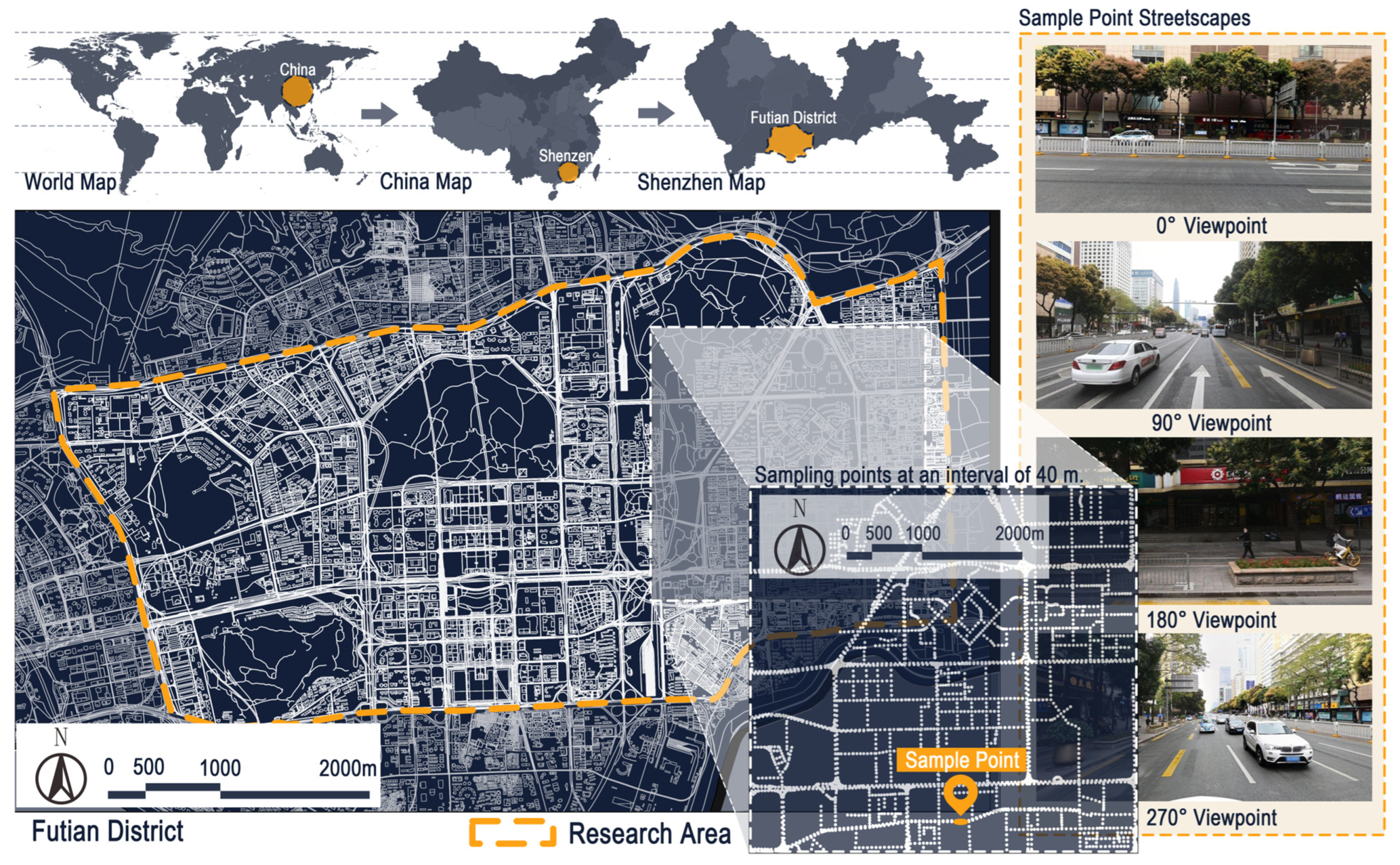
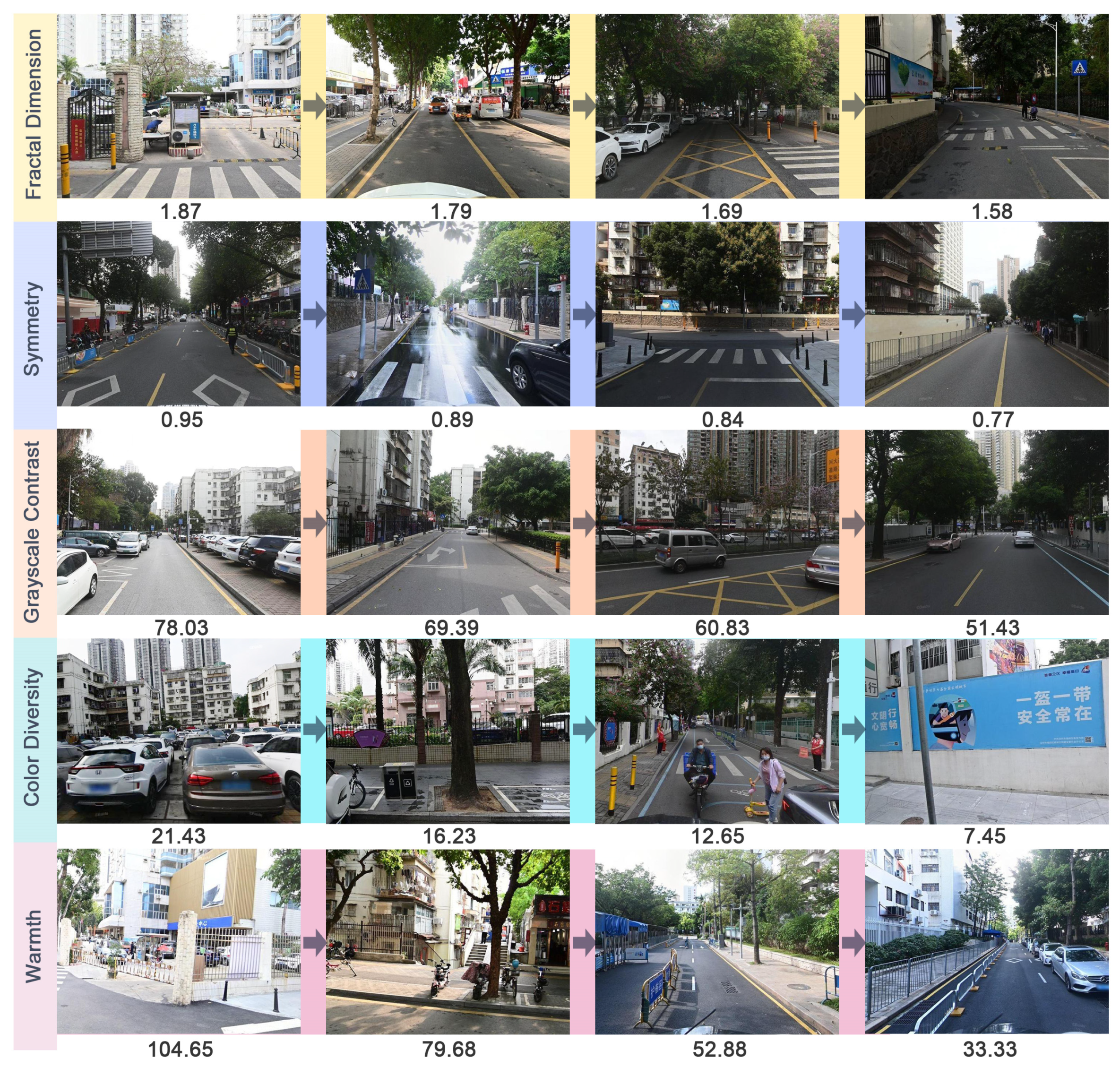

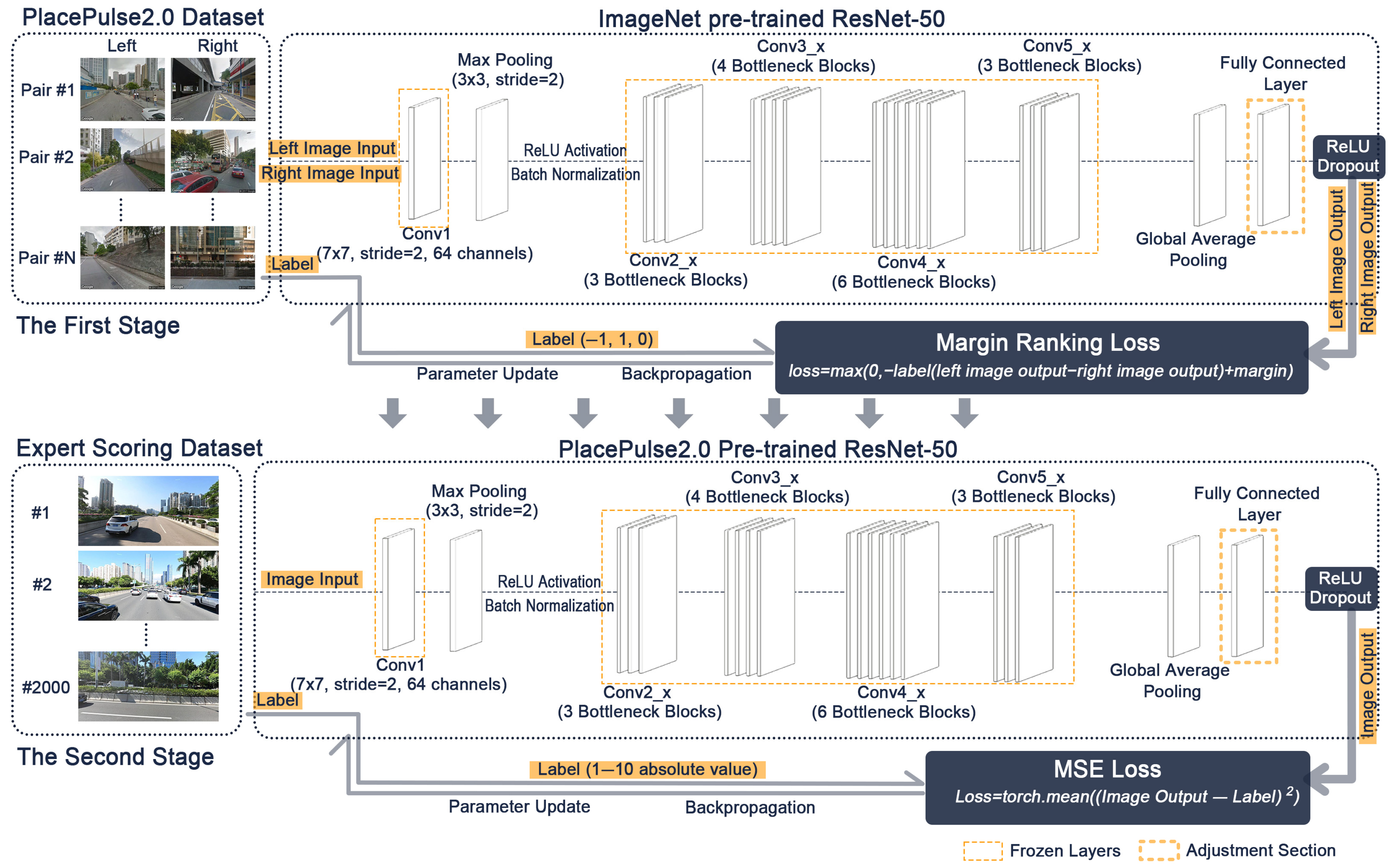
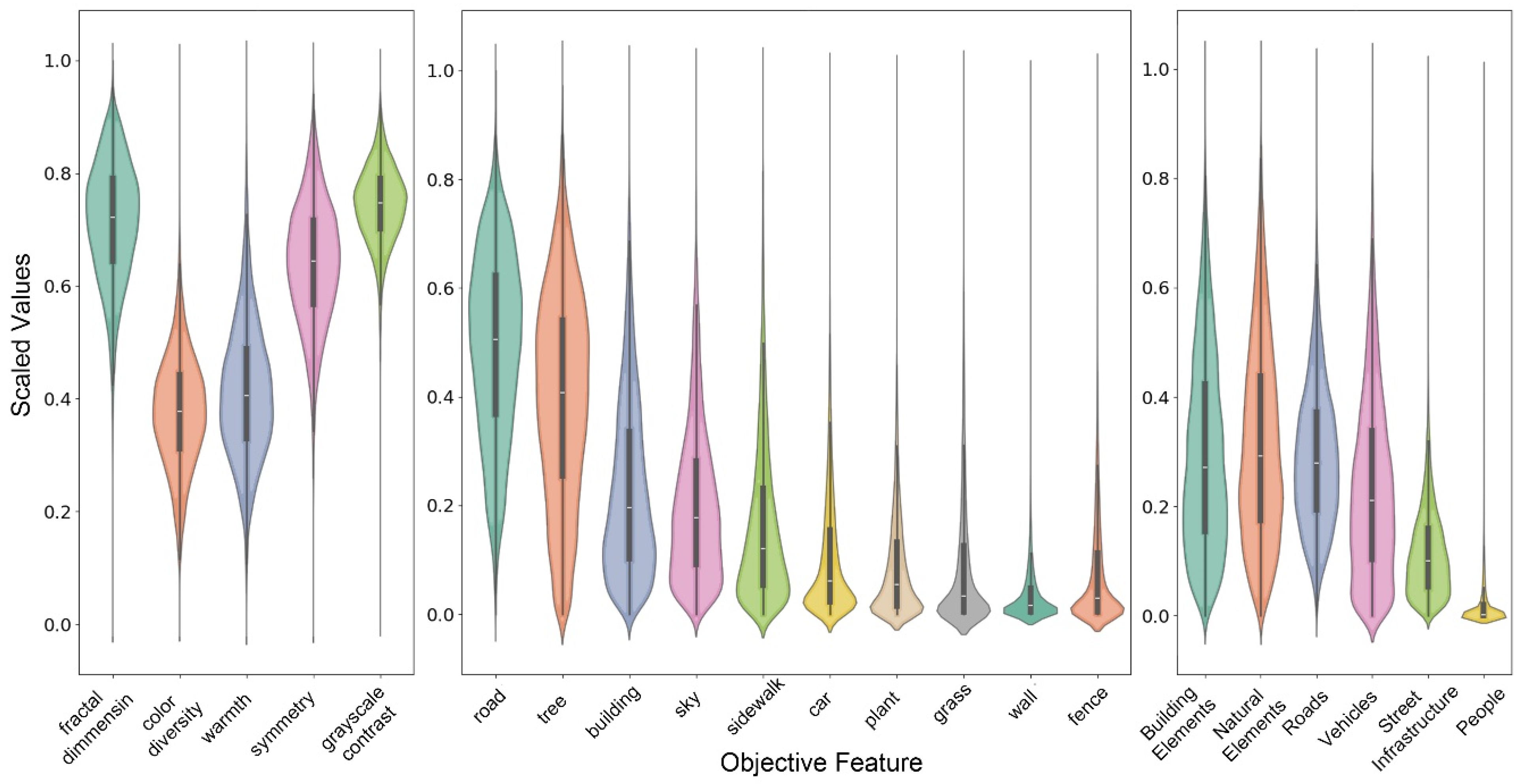
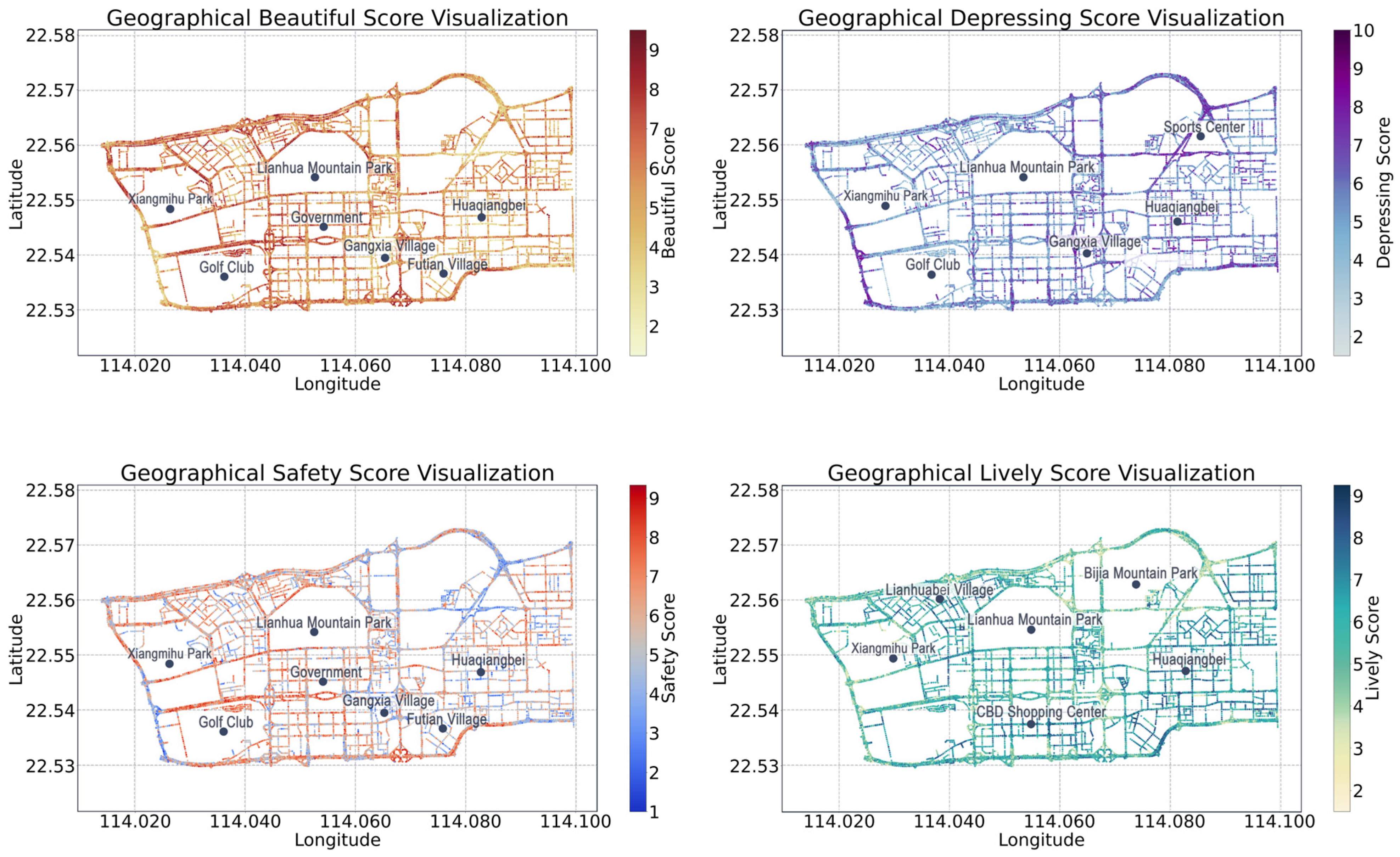

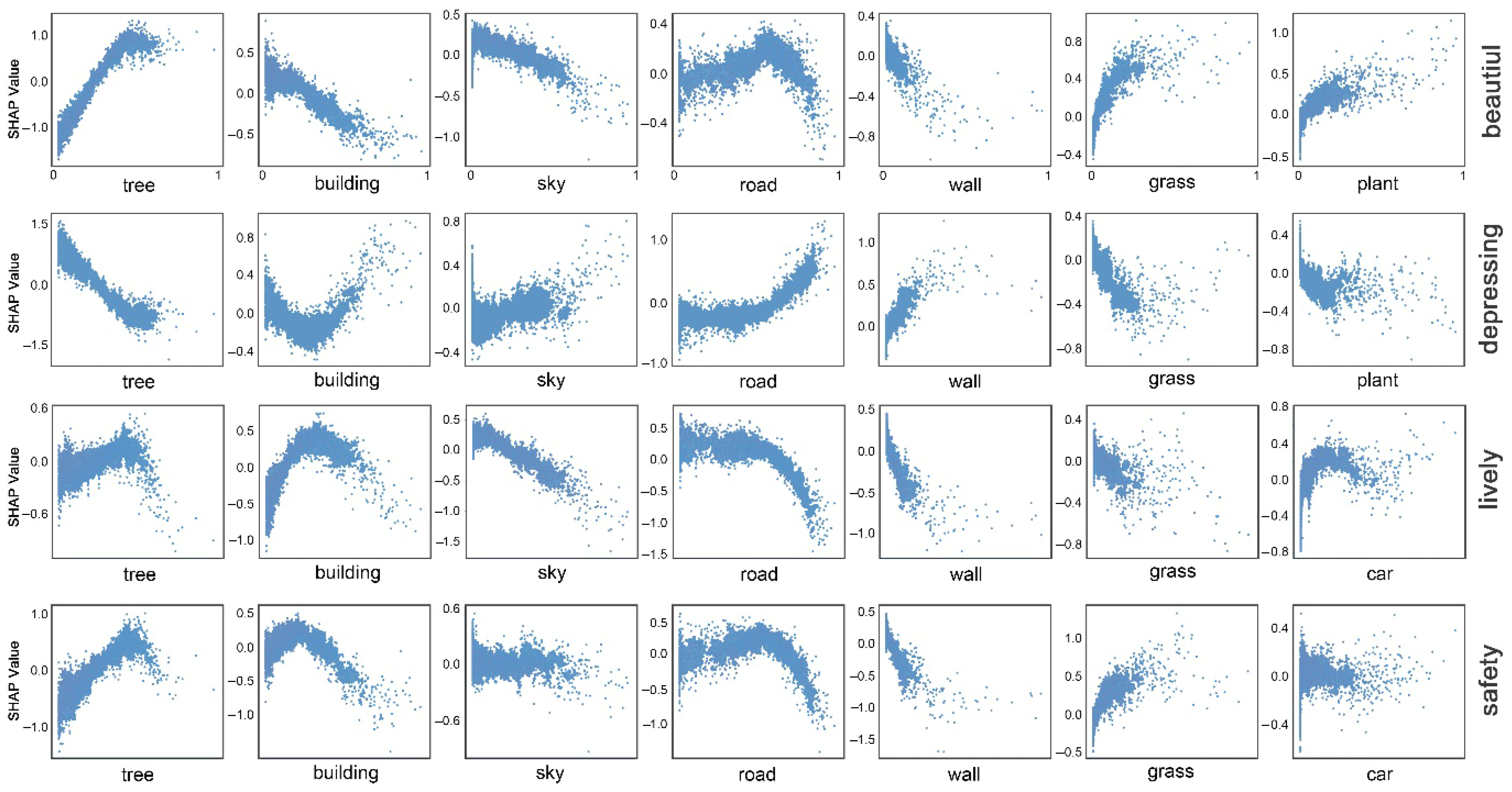
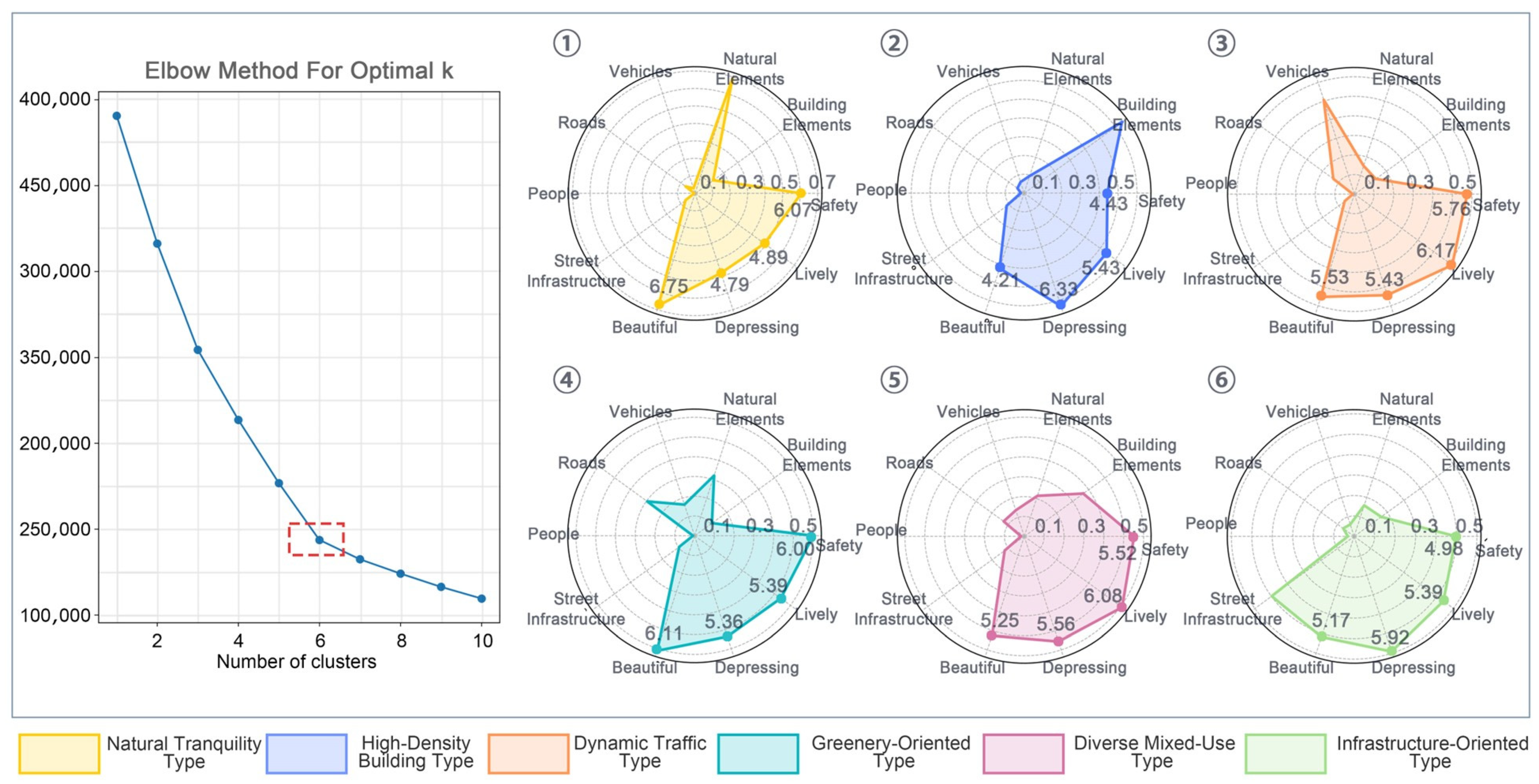
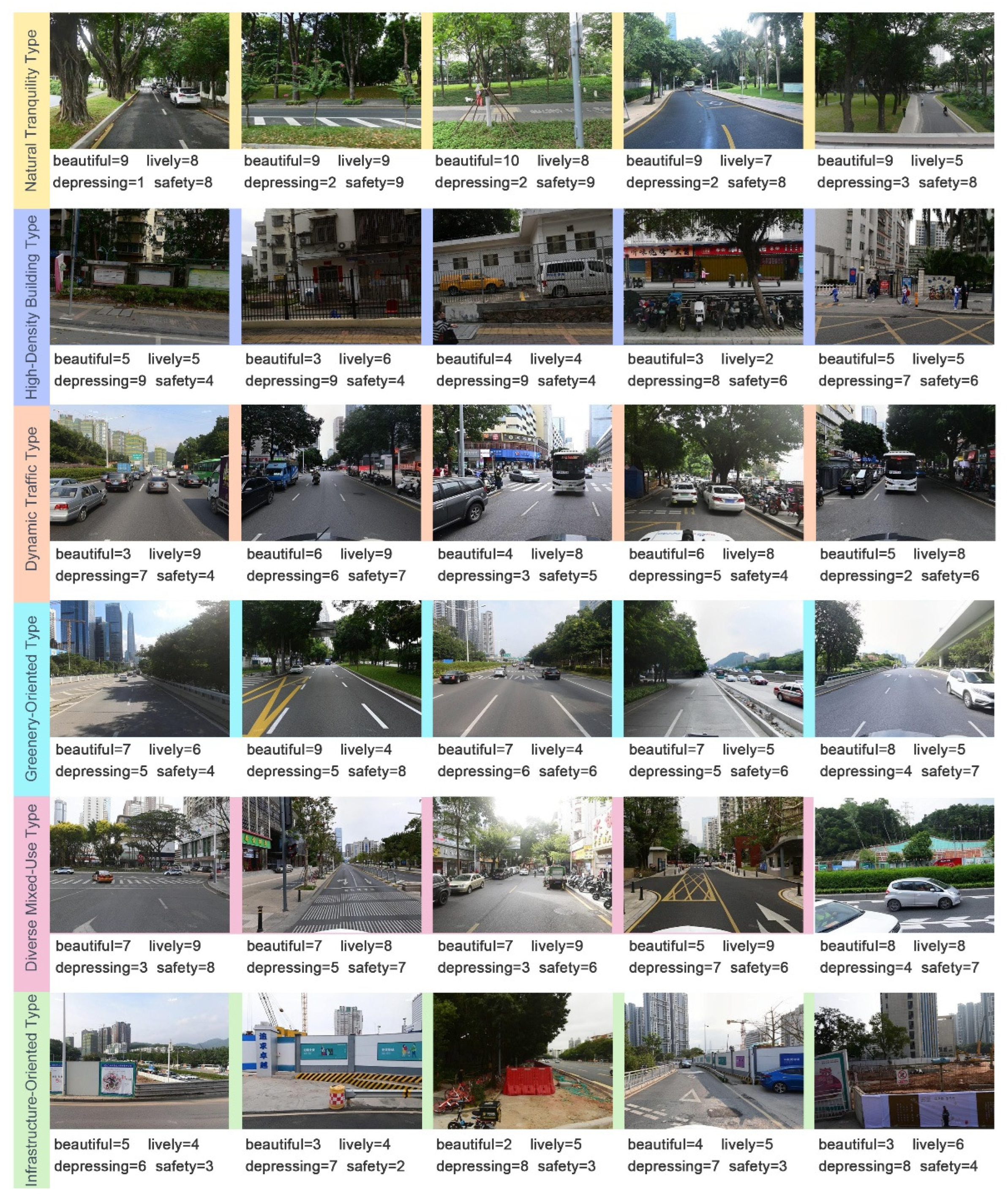
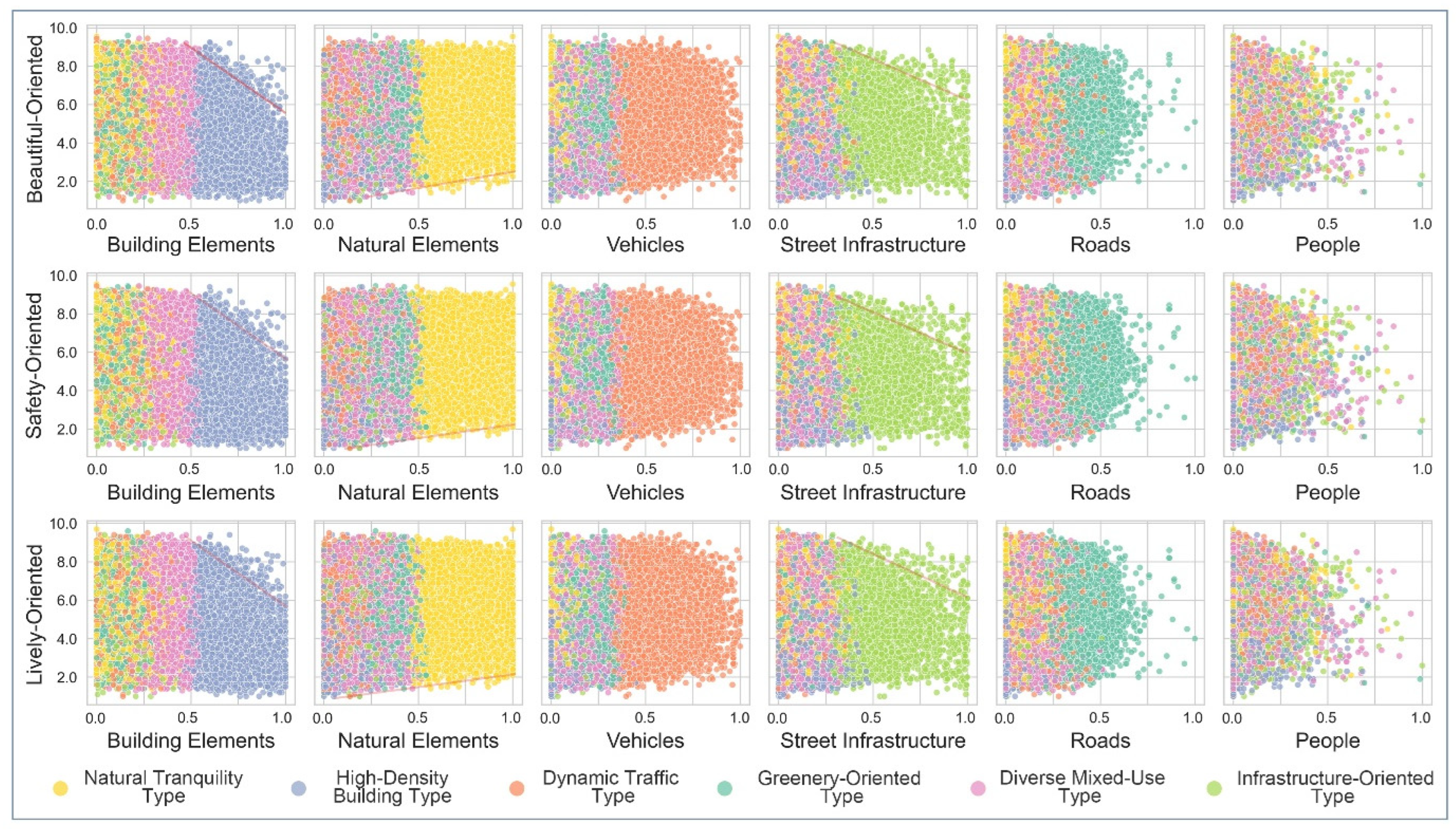



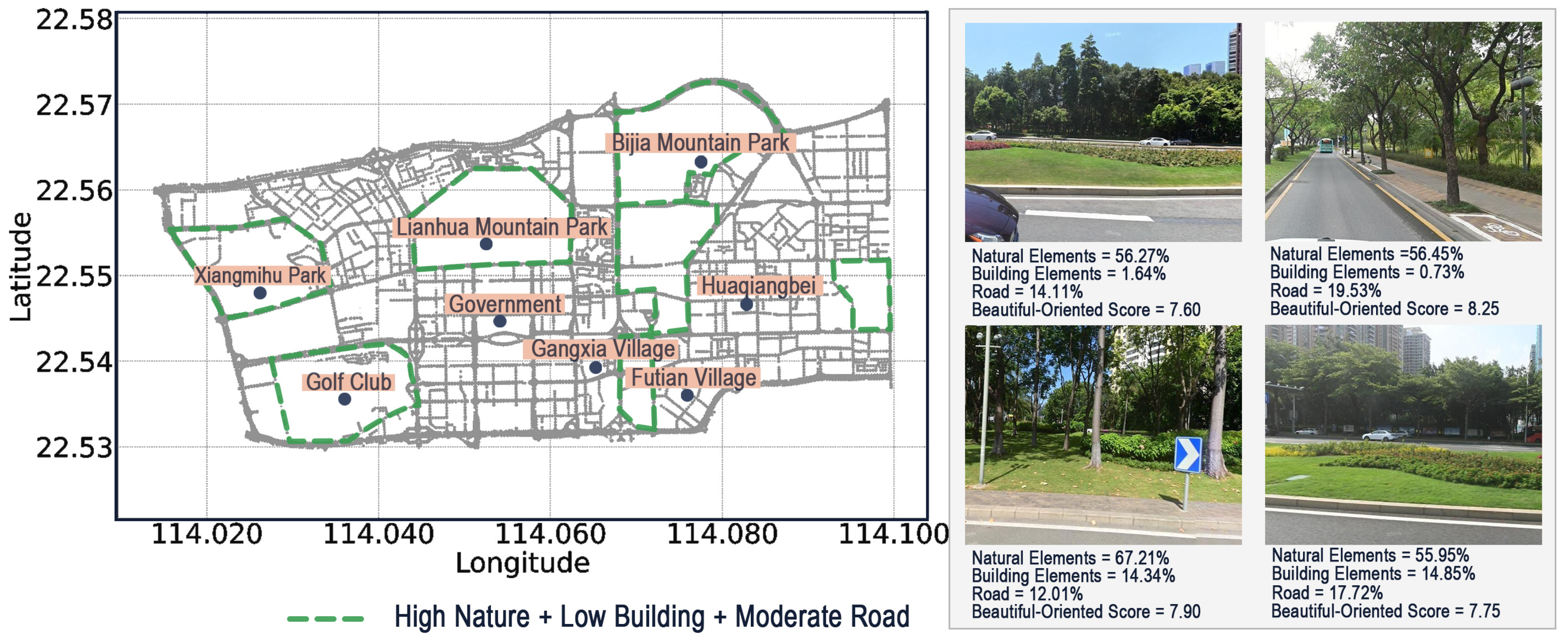
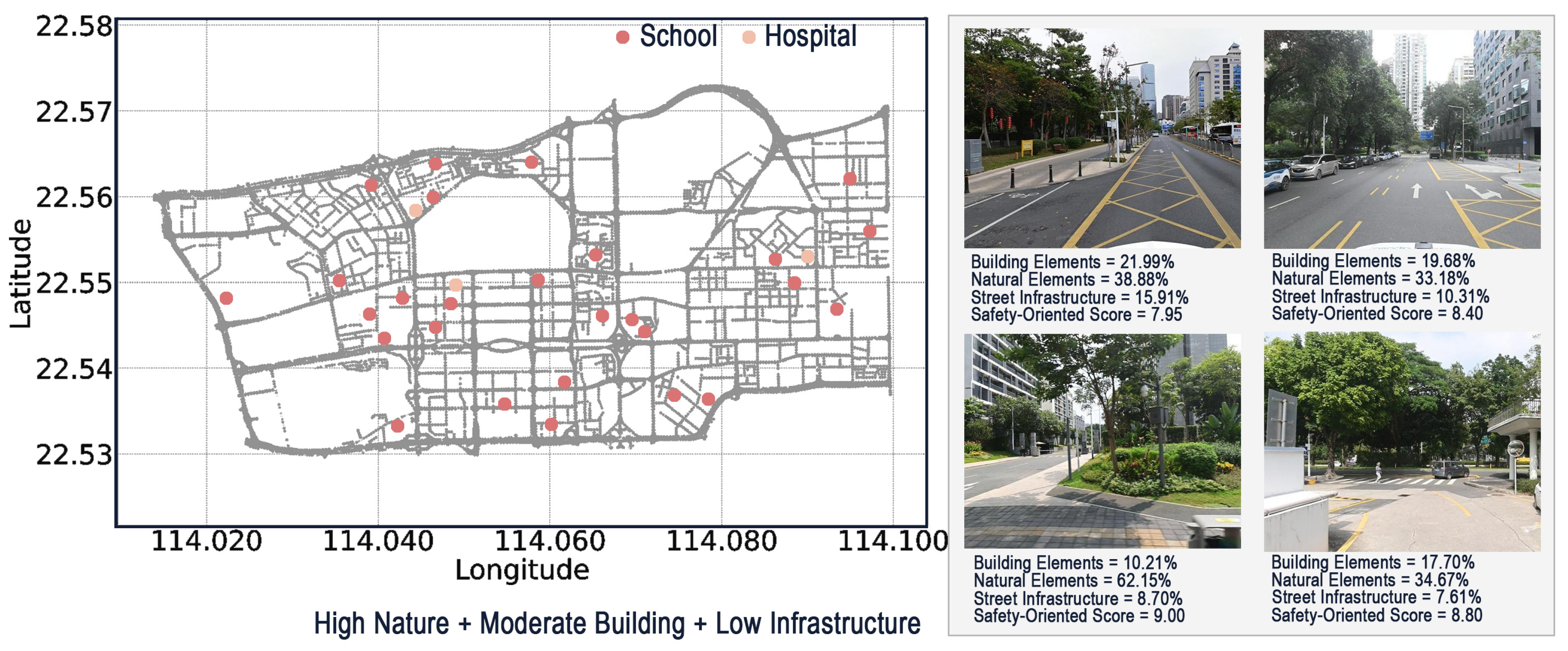
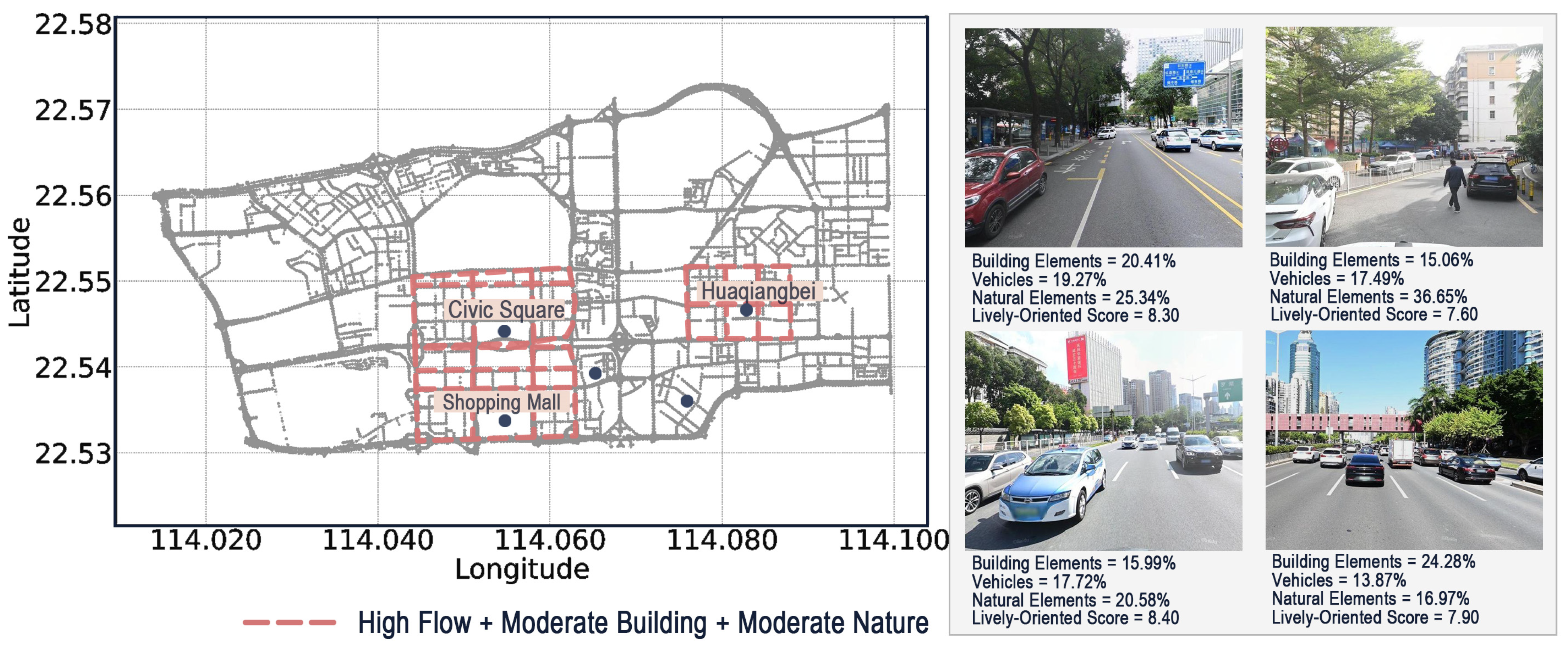
| Category Name | Elements |
|---|---|
| Building Elements | building, wall, column, base |
| Natural Elements | tree, plant, grass, flower, palm, earth, sky |
| Roads | road |
| Vehicles | car, bus, truck, minibike, van, bicycle |
| People | people |
| Street Infrastructure | sidewalk, bridge, signboard, fence, railing, pole, awning, ashcan, poster, box, trade |
| Beautiful | Depressing | Lively | Safety | |
|---|---|---|---|---|
| Accuracy (tolerance = 1) | 80.45% | 75.48% | 82.32% | 77.09% |
| Beautiful | Depressing | Lively | Safety | |
|---|---|---|---|---|
| MAE | 1.08 | 1.15 | 1.09 | 1.12 |
| R2 | 0.53 | 0.44 | 0.52 | 0.49 |
| Perception-Oriented | Base Weight Allocation |
|---|---|
| Beautiful-Oriented | 0.4 × beautiful + 0.25 × safety + 0.2 × livelty + 0.15 × (10–depressing) |
| Safety-Oriented | 0.4 × safety + 0.25 × beautiful + 0.2 × lively + 0.15 × (10–depressing) |
| Lively-Oriented | 0.4 × lively + 0.3 × safety + 0.2 × beautiful + 0.1 × (10–depressing) |
Disclaimer/Publisher’s Note: The statements, opinions and data contained in all publications are solely those of the individual author(s) and contributor(s) and not of MDPI and/or the editor(s). MDPI and/or the editor(s) disclaim responsibility for any injury to people or property resulting from any ideas, methods, instructions or products referred to in the content. |
© 2025 by the authors. Licensee MDPI, Basel, Switzerland. This article is an open access article distributed under the terms and conditions of the Creative Commons Attribution (CC BY) license (https://creativecommons.org/licenses/by/4.0/).
Share and Cite
Suo, W.; Zhao, J. Exploring the Streetscape Perceptions from the Perspective of Salient Landscape Element Combination: An Interpretable Machine Learning Approach for Optimizing Visual Quality of Streetscapes. Land 2025, 14, 1408. https://doi.org/10.3390/land14071408
Suo W, Zhao J. Exploring the Streetscape Perceptions from the Perspective of Salient Landscape Element Combination: An Interpretable Machine Learning Approach for Optimizing Visual Quality of Streetscapes. Land. 2025; 14(7):1408. https://doi.org/10.3390/land14071408
Chicago/Turabian StyleSuo, Wanyue, and Jing Zhao. 2025. "Exploring the Streetscape Perceptions from the Perspective of Salient Landscape Element Combination: An Interpretable Machine Learning Approach for Optimizing Visual Quality of Streetscapes" Land 14, no. 7: 1408. https://doi.org/10.3390/land14071408
APA StyleSuo, W., & Zhao, J. (2025). Exploring the Streetscape Perceptions from the Perspective of Salient Landscape Element Combination: An Interpretable Machine Learning Approach for Optimizing Visual Quality of Streetscapes. Land, 14(7), 1408. https://doi.org/10.3390/land14071408







